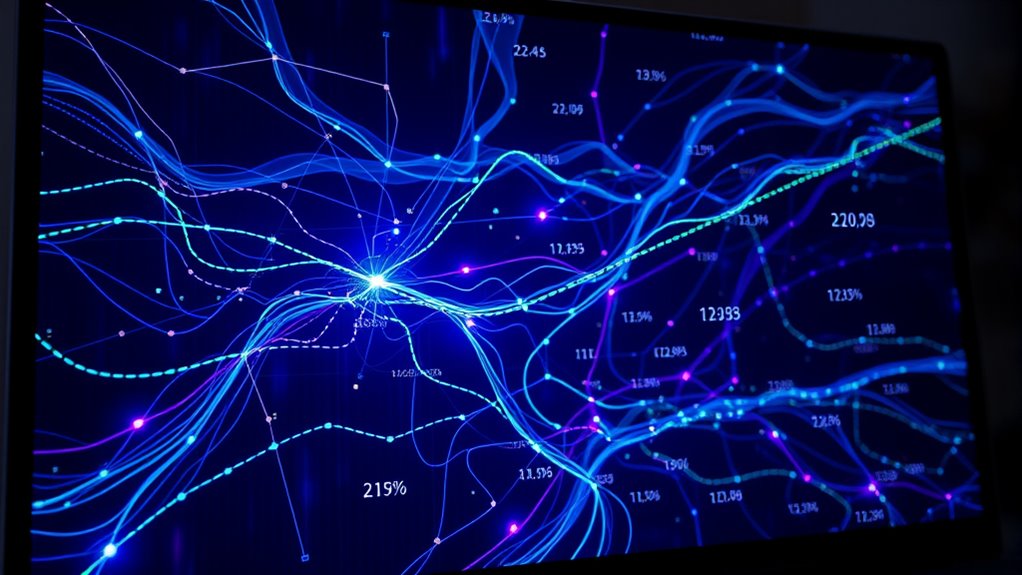Using machine learning for network traffic analysis helps you spot hidden signs of espionage and malicious activity. ML models identify patterns like unusual data flows, abnormal connection timings, or unexpected access points that typical defenses may overlook. These subtle signals often reveal spies or cyber threats trying to blend in. If you keep exploring, you’ll uncover even more techniques to detect covert operations effectively and stay ahead of cyber adversaries.

Have you ever wondered how organizations detect and prevent cyber threats in real time? The answer often lies in analyzing network traffic using machine learning (ML). This technology enables security teams to spot suspicious activities quickly, often before significant damage occurs. When you understand the patterns that ML models look for, you get a clearer picture of how threats are identified and thwarted.
Network traffic analysis involves examining data packets that traverse an organization’s network. These packets contain vital information—such as source and destination IP addresses, ports, protocols, and data payloads. Traditional security systems rely on predefined rules and signatures to flag malicious activity, but cybercriminals continuously evolve their tactics, making these methods less effective. That’s where ML steps in, learning from vast amounts of network data to identify anomalies that don’t fit the usual patterns.
You can think of ML models as vigilant detectives constantly scrutinizing traffic for irregularities. They’re trained on historical data to recognize normal behavior—like typical user access times, common communication channels, and standard data transfer sizes. Once trained, these models can flag deviations, such as sudden spikes in data transfer, unusual access times, or unfamiliar IP addresses. These anomalies often serve as early warning signs of infiltration, malware activity, or data exfiltration attempts.
As you dive deeper into network traffic analysis with ML, you’ll notice that different algorithms serve different purposes. For example, supervised learning models are excellent at identifying known threats by classifying traffic based on labeled training data. Unsupervised models, on the other hand, excel at discovering new, unseen threats by clustering traffic patterns and highlighting unusual groupings. Semi-supervised models combine both approaches, leveraging limited labeled data to improve detection accuracy.
You might also realize that the power of ML in network traffic analysis isn’t just in detection but also in prediction. These models can anticipate potential threats based on emerging patterns, allowing organizations to act proactively. For instance, if an ML system detects a pattern similar to previous ransomware infections, it can trigger alerts or even automate responses to isolate affected parts of the network.
Ultimately, the success of network traffic analysis with ML hinges on continuously updating and refining models. Cyber threats evolve rapidly, and your detection system must adapt just as quickly. By understanding the subtle patterns that give spies away—like irregular traffic, unusual connection times, or unexpected data flows—you can stay one step ahead of cyber adversaries, protecting your organization more effectively than ever before.
Frequently Asked Questions
How Does ML Detect Encrypted Network Traffic?
You can detect encrypted network traffic with ML by analyzing patterns like packet size, timing, and flow behavior, which often reveal anomalies or signatures of malicious activity. ML models learn to identify these subtle cues, even when content is hidden. By continuously monitoring and comparing traffic patterns, you become better at spotting suspicious activities, ensuring your network stays secure without decrypting the actual data.
What Are Common False Positives in Traffic Analysis?
Ever wonder if your traffic analysis can misfire? Common false positives happen when benign activity appears suspicious, like unusual but legitimate data transfers or network scans. You might flag routine software updates or large backups as threats. These false alarms waste your time and can cause unnecessary panic. To reduce them, you need to fine-tune your ML models, focus on context, and continuously update your detection criteria to distinguish real threats from normal behavior.
Can ML Adapt to Evolving Cyber Attack Patterns?
Yes, machine learning can adapt to evolving cyber attack patterns. It continuously learns from new data, identifying emerging threats and adjusting its models accordingly. By analyzing real-time traffic, ML systems detect subtle changes that indicate new attack methods. Your systems become more resilient, reducing false negatives and staying ahead of cybercriminals. This adaptability guarantees your defenses remain effective against constantly changing attack techniques, keeping your network secure.
What Privacy Concerns Arise From Network Traffic Monitoring?
Monitoring network traffic is like watching a busy highway; it raises privacy concerns because your data can be scrutinized without your knowledge. You might worry about sensitive information being intercepted or misused. As you navigate digital spaces, this surveillance can feel intrusive, like someone peering over your shoulder. Ensuring privacy requires strict controls, transparency, and anonymization, so your personal data stays protected amid the flow of network activity.
How Scalable Are ML Solutions for Large Networks?
ML solutions are highly scalable for large networks because they can process vast amounts of data quickly and adapt to growing traffic. You can deploy them across multiple servers or cloud platforms, allowing real-time analysis without significant delays. As your network expands, these systems can be fine-tuned to handle increased complexity, making them an effective tool for maintaining security and performance at scale.
Conclusion
Just like a detective spots clues others miss, machine learning reveals hidden patterns in network traffic. Imagine catching a spy slipping up because of a tiny, unusual signal—something you’d overlook without sharp tools. In fact, studies show ML can identify malicious activity with over 90% accuracy. So, next time you think your network’s secure, remember: with ML, it’s like having a vigilant detective always watching, ready to catch the spies before they strike.








